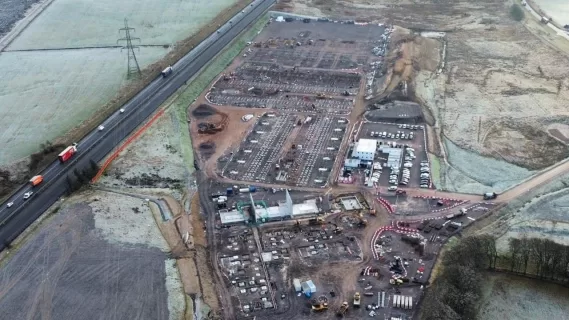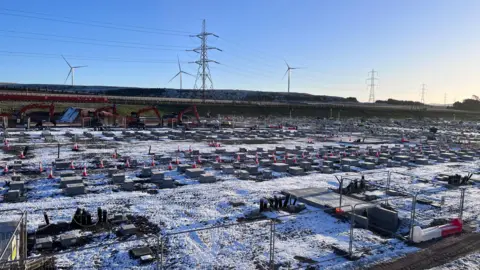The UK is focusing more on constructing what is described as Europe’s biggest battery farm in Coalburn, South Lanarkshire. Developers have noted that the two massive battery farms where work is continuing will have an immense significance. The two farms, one at the site of a former opencast coal mine, will store enough electricity to power three million homes. Battery Energy Storage Systems (BESS) are gradually being constructed across the UK. The main reason is to help balance the electricity grid, which is powered by renewables. Almost 90 per cent of the electricity generated in parts such as Scotland last year was from low-carbon sources. These includes wind, solar or nuclear, according to the Scottish government.
Also read:
World’s Largest BESS Project in Saudi Arabia Announces Prequalified Bidders: 8GWh Battery Storage
The Scope of Implementation on Europe’s Biggest Battery Farm

Europe’s biggest battery farm seeks to see BESS provisions grow almost six times over by the decade’s end. Estimates note that this is integral to help balance the peaks and troughs of renewables. The one-gigawatt facility at Coalburn is being constructed in two phases. It will be charged using excess power from wind farms, and the electricity will be discharged when demand is high. Moreover, it will also be used when renewable generation is low. Work on the first phase commenced in November 2023 and is due to be operational this year. The contracted company, Copenhagen Infrastructure Partners (CIP), has confirmed construction will begin shortly on stage two. This is expected to enhance the country’s energy security, as Nischal Agarwal from CIP noted. He also stated that this would support the UK’s pursuit of a clean power system by 2030 and deliver a net-zero carbon economy by 2050.
The Subtle Battle for Europe’s Battery Crown: Power vs. Storage
While the Glasgow-area Coalburn facility is frequently announced as a European behemoth, it is actually comprised of two physically and technically separate, but related, developments: Coalburn 1 and Coalburn 2. By adding them together, the developers can claim a dominant figure in power capacity (1,000 MW), which represents the maximum amount of energy the system can inject into the grid at any given moment. This high-power capability is vital for short, critical tasks like instantly stabilizing the grid.
In contrast, the Belgian Green Turtle project (at 2,800 MWh) lays claim to the title of Europe’s largest single BESS project by energy capacity. This MWh metric—the total volume of electricity the battery can store—is better suited for shifting massive amounts of energy. A single, enormous 2,800 MWh battery can run for four hours at a high output, making it ideal for soaking up abundant solar or wind power during the day and discharging it consistently throughout the evening peak. This distinction clarifies the true nature of their roles: the Coalburns are the speed-and-power specialists, while Green Turtle is the endurance champion.

Also read:
Top 4 Largest Battery Energy Storage Systems under construction in Europe
Giga Green Turtle, Europe’s largest proposed battery storage project

